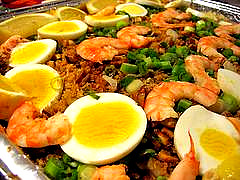 Among the most favorite meal snack of many Filipino today is Pansit Palabok or Pansit Luglug. It is also one of the favorite noodle preparations served in parties and fiestas. Pansit Palabok or Pansit Luglug is an original Filipino recipe made of rice noodles smothered with a thick, golden shrimp sauce and topped with Shrimp, crushed or ground pork rind, hard-boiled egg (sliced into disks or quartered lengthwise or chopped), Tinapa (smoked fish) flakes, and freshly minced green onion.
Among the most favorite meal snack of many Filipino today is Pansit Palabok or Pansit Luglug. It is also one of the favorite noodle preparations served in parties and fiestas. Pansit Palabok or Pansit Luglug is an original Filipino recipe made of rice noodles smothered with a thick, golden shrimp sauce and topped with Shrimp, crushed or ground pork rind, hard-boiled egg (sliced into disks or quartered lengthwise or chopped), Tinapa (smoked fish) flakes, and freshly minced green onion.
Pansit Palabok is the local answer to the popular Spaghetti of the West. Like its Western counterpart, Pancit Palabok has a colored sauce topped on a heap of bihon or thin noodles. It is prepared distinctively the very Asian way as it uses ingredients closest to home and it sauce has that salty, smokey and sweet flavors, combined perfectly with chicharon or pork skin cracklings and seafood.
Pansit Palabok or Pansit Luglug was first popularized in Luzon particularly in the provinces of Tarlac and Pampanga. In fact the word “luglug” is said to have originated from a Kapampangan description which means “washed with warm water”. In the olden days, this dish is served with kamias (balimbi) to provide contrast to the sweet and salty flavor. Today, calamansi is sprinkled on top of the dish before it is eaten.
Another variety of this dish is found in the Tagalog region. This is called Pansit Malabon. The only difference is that this version uses bigger rice noodles with sizes similar to that of the regular spaghetti noodles. It is also firmer than the bihon. However, between the two preparations, the Tarlac-Pampanga version is most preferred here and abroad because bihon is most available in stores and supermarkets.
Ingredients:
- 1 kilo bihon or thin rice noodles, washed
- 1/4 kilo fresh water shrimps
- 1/4 kilo squid, cooked in adobo style and cut in strips (exclude sauce)
- 1/2 kilo smoked fish preferably bangus (milk fish) or tamban (herring sardinella), deboned and flaked
- 2 blokes tokwa (bean curd), fried and cut into strips
- 2 pieces large boiled eggs, sliced length-wise (keep egg yolks and whites together)
- 500 grams chicaron (popped pork skin), flaked
- 1 head garlic, minced
- 1 medium sized onion
- 1 teaspoon salt
- 1 tablespoon vegetable oil
- 1 piece laurel leaf
- 1 small pack of annatto seeds
- 2 cup hot water
- 3 tablespoons cornstarch, dissolved in water
- 7 pieces of calamansi, sliced
- 1 cube shrimp flavor
- 1/4 cup fish sauce
- Ground pepper
- A few stalks of onion leaves, chopped
Procedure
Sauce:
- Soak annatto seeds in a cup of hot water to release the red coloring . Set aside
- Take off heads and shells of the shrimps. Soak a cup of hot water for one minute. Set aside the water with raw shrimp essence and pound the heads and shell squeeze out the remaining juice.
- Cut shrimp meat in desired sizes and set aside.
- Saute garlic and onion in oil in a deep casserole. Then add shrimps and salt to taste. Stir fry until shrimps are cooked.
- Pour in the shrimp essence and juice. (optional) To add more shrimp flavor dissolve shrimp cubes into the broth. Cover the Bring to boil.
- Add in the annatto seeds juice into the broth. Squeeze out the remaining juice of the atsuete from a strainer. Add water if necessary.
- Simmer for 3-5 minutes. Then stir in cornstarch in water to thicken.
Noodles:
- Soak the thin rice noodles into a pot of boiling water until al dente.
- Remove immediately. Strain remaining water from noodles.
Arrangement:
1. Spread the cooked thin rice noodles on a large platter or bilao. If placed on a bilao, line it with foil to prevent spillage and leaking.
2. Top the whole noodles in the following order:
- Sauce
- Chicharon
- Tokwa
- Squid
- Smoked fish
- Boiled eggs
3. Garnish it with onion leaves and sliced calamansi.
4. Serve while it’s hot with pepper and fish sauce on the side.
Source: Wikipedia.org; Photo: fil.wikipilipinas.org